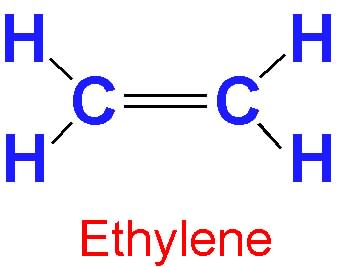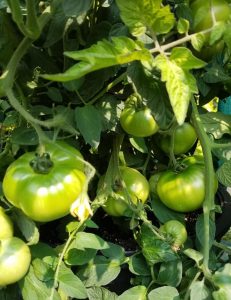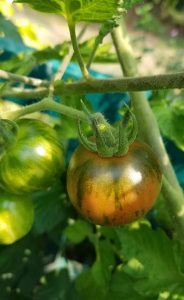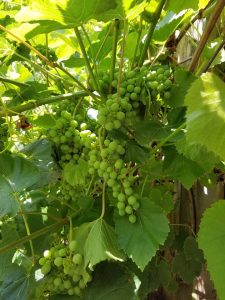In many publications and garden resources you see the suggestion to remove flower buds to improve establishment of new fruit and vegetable plants. This advice is shared for both woody and perennial plants like fruit trees and strawberries and for annuals like tomatoes and peppers. And whenever you see someone stating this as gospel, you see someone else stating that it is false or only anecdotal. So the question is – does research support the advice to remove early plant blossoms to improve vegetative plant growth and establishment? Let’s take a look at some recent, and not so recent, research to see what really happens and understand the process.
The Physiological Process
Prior to my extension career teaching people gardening, I fancied myself a budding (ha ha) plant science researcher. Many of my classes, therefore, were focused on plant physiology and genetics. Not necessarily handy in teaching people the basics of gardening, but pretty damn handy in explaining how plant processes work.
As most upper elementary and middle school students will tell you, plants make their own food in the form of the sugar glucose by using energy from the sun through photosynthesis. That glucose is used in the respiration process to release the energy for the plant to use, transformed into other sugars and compounds for functions around the plant, or turned into starch for long-term storage. Photosynthesis is not an unlimited process and genetics, environment, and other factors play a role in the rate of energy development. So it stands to reason that there are lots of things that have to happen with the finite resources made by the plant.
In plant physiology circles, photosynthesis is called the “source” of plant energy and those uses, such as root, leaf, stem, wood, flower, and fruit production and storage are called “sinks” (sometimes also “pools”). Researchers often discuss these pathways as “source-sink” interactions. Since there are only so many carbohydrates to go around, researchers have long known that when demand is high for growth of certain structures that development of other structures is slowed. If there is a period of rapid root growth, the demand for carbohydrates in the roots increases and the availability for other locations in the plant is decreased. As a result growth in the leaves, stems, or reproductive organs may slow until a supply is restored. But this phenomenon varies by plant species and even cultivar/type, as genetics does play a role in the rate of photosynthesis. Some plants have a higher level of photosynthesis to help offset the sudden upswing of need, and some don’t.
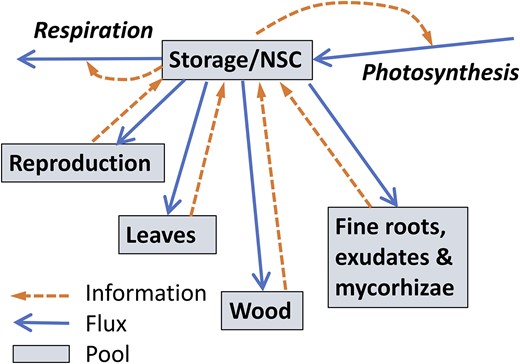
Think of it like a household budget, but you have a job that only pays you in months that are warm and sunny. You have a set monthly income (the source) and then your housing, utilities, food, and other bills to pay (the sinks). Plus, hopefully you are saving some money for later somehow (another sink). If your bill sinks are greater than your income source, you might dip into your savings a bit, but you don’t want to take it all because you will need most of it in the months when you don’t get paid because it is cold and dreary, or your leaves have fallen off, or your herbaceous bits have died back. As a plant you don’t qualify for credit so the only way to make things work is to cut back in some areas (a sad reality for many on limited incomes). You have to reduce your utility usage, cut back on more expensive foods, find cheaper rent, etc. Similarly, a plant has to reduce the amount of energy used for, say, root growth if it has a rapid leaf growth.
And if you have a kid then the expenses go way up, right? That’s what happens when a plant is just minding its business, enjoying a free and frivolous lifestyle when all of a sudden reproduction comes along. First flower structure development, then fruit development. Plants that have a higher rate of photosynthesis have a higher budget to pull from, so the change may be minimal. But when photosynthesis rates are low, like in newly developing plants with few leaves, unfavorable environments, or genetic limits, the effect can be significant.
So, what about my plant?
The question we always get is, “is it necessary to remove the early blossoms on my ______ plant to help it get established?” For perennials like fruit trees, that would generally be the first few years. For annuals like tomatoes, it would be removing blossoms the first few weeks after planting (and removing any blossoms developed before transplanting). The answer is…maybe. Or more like, there probably is an effect, but it depends on the plant and environment as to how impactful the effect is. This phenomenon has been observed in several species, including Douglas fir, peaches, olives, and more.
For example, research shows that letting blueberry bushes fruit the first two years after planting (not removing flowers or fruits) reduces the biomass (vegetative growth) AND the yield in year 3. The plants will likely catch up in later years, but if your goal is to get plants established early and have fuller harvests sooner, removing flowers in years 1 and 2 would be advisable.
The same can be said for strawberries. The abstract from this paper from 1953 (I couldn’t track down the full article prior to publication) says that “removal of blossom from newly set strawberry plants helps more in the establishment of a vigorous planting than almost any other cultural operation.” This paper doesn’t measure biomass, but did find that removing flowers on day-neutral strawberries (that produce throughout the growing season) until July 1 resulted in maximized yields in the later season and removal of flowers for the entirety of the first year resulted in maximized yields in year 2 (note: in commercial strawberry production, strawberries are usually grown as an annual or at most a biennial, so maximizing early yields is important).
Now, for the all important tomato (drumroll, please). This study from the 70s found that removal of early blooms on indeterminate tomato plants resulted in larger plants (higher vegetative growth) and that eventually the fruit yield nearly caught up with the controls. They found that when fruit development started, leaf growth was “markedly depressed” and root growth ceased (and there was even some root death). So while there was ultimately a small loss of yield, the result was a better established plant that would likely be able to better weather environmental and disease issues throughout the season.
And beyond establishment, flower and/or fruit thinning on plants with high floral numbers has been shown in many plants (apples, blueberries, peaches, and tomatoes, to name a few) to result in larger, higher quality fruits. The same pathways apply here – each and every fruit is a sink. The more sinks you have, the more “mouths” the plant has to feed. So flower removal is a viable production strategy for many different crops and something that home gardeners should think about if you want the biggest, and juiciest fruits on the block.

Sources:
- Chanana, Y. R., et al. “Effect of flowers and fruit thinning on maturity, yield and quality in peach (Prunus persica Batsch).” Indian Journal of Horticulture 55.4 (1998): 323-326.
- Dejong, Theodore M., and Yaffa L. Grossman. “Quantifying sink and source limitations on dry matter partitioning to fruit growth in peach trees.” Physiologia Plantarum 95.3 (1995): 437-443.
- Eis, S., E. H. Garman, and L. F. Ebell. “Relation between cone production and diameter increment of Douglas fir (Pseudotsuga menziesii (Mirb.) Franco), grand fir (Abies grandis (Dougl.) Lindl.), and western white pine (Pinus monticola Dougl.).” Canadian Journal of Botany 43.12 (1965): 1553-1559.
- Hesami, Abdolali, Saadat Sarikhani Khorami, and Seyedeh Samaneh Hosseini. “Effect of shoot pruning and flower thinning on quality and quantity of semi-determinate tomato (Lycopersicon esculentum Mill.).” Notulae Scientia Biologicae 4.1 (2012): 108-111.
- Hurd, R. G., A. P. Gay, and A. C. Mountifield. “The effect of partial flower removal on the relation betwen root, shootand fruti growth in the indeterminate tomato.” Annals of Applied Biology 93.1 (1979): 77-89.
- Kim, Jin-Gook, et al. “Effects of cluster and flower thinning on yield and fruit quality in highbush’Jersey’blueberry.” Journal of Bio-Environment Control 19.4 (2010): 392-396.
- Link, H. “Significance of flower and fruit thinning on fruit quality.” Plant growth regulation 31 (2000): 17-26.
- Michael G Ryan, Ram Oren, Richard H Waring, Fruiting and sink competition, Tree Physiology, Volume 38, Issue 9, September 2018, Pages 1261–1266, https://doi.org/10.1093/treephys/tpy114
- Rosati, Adolfo, et al. “Fruit production and branching density affect shoot and whole-tree wood to leaf biomass ratio in olive.” Tree Physiology 38.9 (2018): 1278-1285.
- Scott, D. H., and P. C. Marth. “Effect of blossom removal on growth of newly set strawberry plants.” (1953): 255-6.
- Solomakhin, Alexey A., and Michael M. Blanke. “Mechanical flower thinning improves the fruit quality of apples.” Journal of the Science of Food and Agriculture 90.5 (2010): 735-741.
- Williamson, Jeffrey G., and D. Scott NeSmith. “Evaluation of flower bud removal treatments on growth of young blueberry plants.” Hortscience 42.3 (2007): 571-573.


